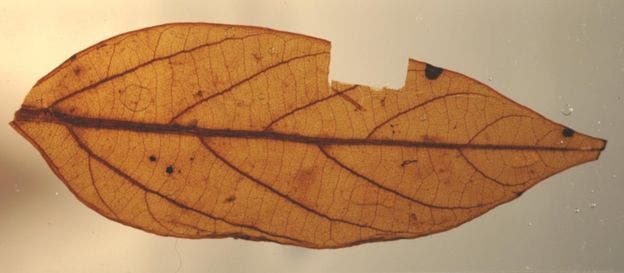An analysis of fossilized, 23 million-year-old tree leaves suggests that plants could adapt to capture more CO2 as emission levels continue to rise.

However, this is not necessarily good news. Such an adaptation would not be enough to clean up all the greenhouse gases we’re releasing, the authors note. At the same time, there is growing evidence that, while more CO2 absorption leads to faster growth, it also reduces the nutritional values of crops as they take in a lower amount of minerals from the ground. The alterations to plant activity could also produce unforeseen consequences for ecosystems.
Still, the findings are interesting as they offer us a glimpse into how plants might behave in the near future.
In high supply
The findings are based on fossilized leaves from a 23 million-year-old forest preserved in an ancient lake on South Island, New Zealand.
The team drilled down around 100 meters to get to the ancient bottom of the (now-dry) lake, which rests in the crater of an inactive volcano. This layer is known for its wealth of fossils of all kinds from the early Miocene Epoch. Average temperatures during this time are estimated to have been between 3C and 7C higher than today, enough to melt virtually all ice from the poles.
What the researchers wanted to determine from these fossils was how much CO2 was in the atmosphere at the time. Because of how well preserved they are, the team was able to perfectly analyze their microscopic structure, including the veins and stomata (pores through which plants take in CO2 and sweat out water during photosynthesis).
“The amazing thing is that these leaves are basically mummified, so we have their original chemical compositions, and can see all their fine features under a microscope,” said lead author Tammo Reichgelt, from the University of Connecticut in Storrs, US.
They also looked at the carbon isotope ratios in the leaves of around 6 different fossil tree species at the site. Based on this, they estimated a concentration of CO2 in the atmosphere at the time of around 450 parts per million (ppm), which is much higher than previous estimations of around 300 ppm. This previous figure was contested because it conflicted with the temperature estimates for the period (but the new one fits like a glove).

Today, we’re looking at around 415 ppm of CO2 in the atmosphere, chiefly due to human emissions. They are expected to reach 450 ppm again in the next few decades.
However, based on the leaves’ structures, the team also believes that they were much more adept at capturing CO2 from the air than those of today — and they released much less water in the process. This would lead to a more efficient photosynthesis process and allow forests to develop in drier areas than today.
Although the findings are from New Zealand, plants in the Northern Hemisphere likely behaved the same way.
This hypothesis ties in well with previous findings from NASA satellites that show a “global greening” effect tied to the CO2 we release. An estimated 25% to 50% of plant-bearing areas on the planet have seen an increase in leaf volume since 1980, the agency adds.
The authors caution that this isn’t necessarily good news. Better photosynthesis won’t be enough to put a dent in human emissions, and natural as well as agricultural ecosystems could see massive disruptions (as they originally evolved to suit the current levels of CO2). Alongside rising temperatures and shifts in precipitation patterns brought about by climate change, they could be in for quite a shock. Furthermore, not all plants will be able to capitalize on the increased CO2, the authors caution, as they’re limited by available nutrients and water.
“How it plays out is anyone’s guess,” said Dr Reichgelt. “It’s another layer of stress for plants. It might be great for some, and horrible for others.”
The paper “Elevated CO2, increased leaf-level productivity, and water-use efficiency during the early Miocene” has been published in the journal Climate of the Past.






